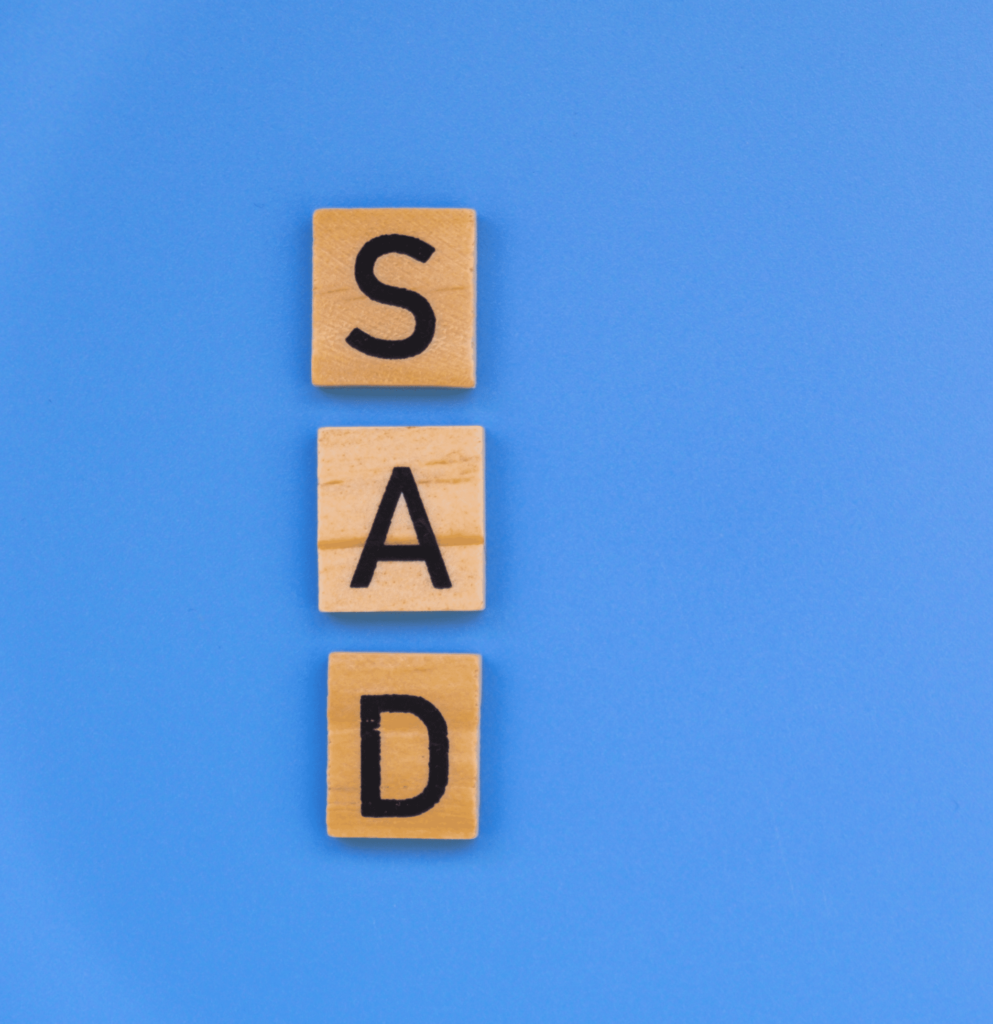 As the time change takes effect, winter sets in, and the sun sets earlier and earlier, many people start feeling the “winter blues.” This isn’t just a passing mood – for some, it may be Seasonal Affective Disorder (SAD), a type of depression that typically begins in fall or winter and lifts in spring or summer. SAD affects mental health, mood, and energy levels, making it challenging to get through the colder months. However, understanding the symptoms, causes, and treatments for SAD can help you prepare and manage the season more effectively, and allow you to move through the winter months with a little more ease.
As the time change takes effect, winter sets in, and the sun sets earlier and earlier, many people start feeling the “winter blues.” This isn’t just a passing mood – for some, it may be Seasonal Affective Disorder (SAD), a type of depression that typically begins in fall or winter and lifts in spring or summer. SAD affects mental health, mood, and energy levels, making it challenging to get through the colder months. However, understanding the symptoms, causes, and treatments for SAD can help you prepare and manage the season more effectively, and allow you to move through the winter months with a little more ease.
What is Seasonal Affective Disorder (SAD)?
SAD is a type of depressive disorder that is directly related to seasonal changes, especially the reduced sunlight during the fall and winter. SAD shares many symptoms with other depressive disorders, such as fatigue, low mood, and loss of interest in activities. However, unlike other types of depression, SAD has a specific trigger: lack of sunlight.
This means that while the symptoms of SAD are similar to those of major depression, they often ease on their own as the seasons change and are predictable in a sense. Even so, SAD can disrupt daily life and mental well-being during the darker and colder months. Recognizing the symptoms early on and implementing coping strategies can help you manage these winter blues.
Common Symptoms of Seasonal Affective Disorder (SAD)
The symptoms of SAD often overlap with other types of depression, but they tend to follow a seasonal pattern. If you find yourself experiencing these symptoms as the days get shorter, you may be dealing with SAD. Common symptoms include:
- Persistent sadness or feelings of worthlessness
- Loss of interest or pleasure in activities you usually enjoy
- Low energy and feelings of sluggishness
- Changes in sleep patterns, such as insomnia or hypersomnia (excessive sleeping)
- Changes in appetite
- Difficulty concentrating
- Irritability and increased sensitivity to stress
- Increased anxiety or agitation
- Suicidal thoughts (in severe cases)
If you or someone you know is experiencing suicidal thoughts, it’s essential to seek help immediately. SAD is a serious condition that requires attention, and help is available.
What Causes Seasonal Affective Disorder?
While the exact cause of SAD isn’t fully understood, researchers believe it’s primarily linked to changes in light exposure. The decrease in sunlight during fall and winter can disrupt your body’s natural processes in several ways:
- Reduced Light Exposure: Less sunlight affects your body’s ability to maintain its circadian rhythm (internal clock), which plays a key role in mood regulation.
- Melatonin Imbalance: Melatonin, a hormone that helps regulate sleep, can be produced in excess due to longer nights, leading to drowsiness and low energy.
- Serotonin Changes: Serotonin, a neurotransmitter that affects mood, may decrease in response to reduced sunlight, contributing to symptoms of depression.
Risk Factors for Seasonal Affective Disorder
Several factors can increase the likelihood of experiencing SAD:
- Geography: People living far from the equator, where daylight hours are shorter in winter, are more prone to SAD.
- Family History: A family history of depression or SAD can increase susceptibility, suggesting a genetic link.
- Personal Mental Health History: Individuals diagnosed with bipolar disorder or major depressive disorder often report worsening symptoms in winter.
Effective Treatments for Seasonal Affective Disorder
While Seasonal Affective Disorder is challenging, several effective treatments can help manage symptoms and improve your well-being. Exploring these treatment options can provide relief and help you regain control over your mood and energy.
1. Light Therapy
Light therapy, or phototherapy, is one of the most effective treatments for SAD. It involves using a light box that emits bright light similar to natural sunlight. Regular sessions (about 20-30 minutes each morning) can help reset your internal clock, regulate melatonin production, and improve mood.
According to the Mayo Clinic, when choosing a light therapy box, look for one with a minimum of 10,000 lux and consider positioning it about 16-24 inches from your face for best results. Be sure to consult with a healthcare provider before starting, as light therapy may not be suitable for everyone, particularly those with eye conditions.
2. Medication
For individuals with severe SAD, antidepressants may be prescribed to help manage symptoms. These medications can regulate serotonin levels and improve mood. Selective serotonin reuptake inhibitors (SSRIs) are commonly prescribed for SAD, but be sure to discuss options with a healthcare provider to determine what’s right for you.
Additionally, melatonin supplements may help align your circadian rhythm with the winter months. Speak with your doctor about appropriate dosage and timing if considering melatonin as a supplement.
3. Talk Therapy
Therapy, particularly Cognitive Behavioral Therapy (CBT), is an effective tool for managing SAD. CBT helps people identify and change negative thought patterns, develop coping skills, and create strategies for improving mood.
10 Practical Tips for Managing Winter Blues
In addition to professional supports, there are lifestyle adjustments and daily practices that can help reduce the impact of SAD symptoms. These practical tips can empower you to feel more in control and regulated during the winter months.
Maximize Natural Light Exposure
- Spend Time Outdoors: Even on cloudy days, spending time outside helps boost your exposure to natural light. Try to go outside in the morning or early afternoon for the best effect.
- Use Light Therapy Lamps Indoors: If you’re unable to get enough natural light, using a light therapy lamp can help. Position it in your workspace or morning routine area for regular exposure.
Stay Active and Keep Moving
- Exercise Regularly: Physical activity is known to boost mood and energy levels. Aim for at least 30 minutes of moderate exercise daily, whether it’s a brisk walk, yoga, or a winter sport.
- Embrace Winter Activities: Embracing seasonal sports like skiing, ice skating, or even hiking in winter can help you stay active and enjoy the season.
Create a Winter Routine
- Prioritize Sleep and Self-Care: Maintaining a consistent sleep schedule and engaging in self-care practices are essential. SAD can increase feelings of isolation, so a regular routine can provide structure and stability.
- Connect Socially: SAD symptoms can make socializing difficult, especially when on top of low mood you have to brave dark nights and chilly weather – but connecting with loved ones is crucial. Regularly scheduled calls, coffee meetups, or virtual hangouts can help combat loneliness.
Explore Nutrition and Supplementation
- Consider Vitamin D Supplements: Many people experience lower vitamin D levels in winter, which can contribute to depressive symptoms. Talk to a healthcare provider about testing your levels and determining if a supplement is right for you.
- Eat a Balanced Diet: Winter can bring different food cravings and big holiday meals, but a balanced diet with fruits, vegetables, lean proteins, and complex carbohydrates can improve energy and mood. No need to avoid all of the delicious holiday celebrations, but incorporate those meals into a larger balanced diet for the season. This can be a great opportunity to experiment with seasonal cooking as well.
Try Mindfulness and Relaxation Techniques
- Mindfulness Meditation: Mindfulness practices can help manage stress and promote mental clarity. Try short daily meditation sessions to help refocus and relax.
- Journaling: Writing down your thoughts and feelings can help process emotions and provide an outlet for expressing concerns and hopes during the winter months.
FAQs About Seasonal Affective Disorder
Q: How long does it take for light therapy to work for SAD?
A: According to the NHS, many people start to feel improvement within 1-2 weeks of daily light therapy sessions, though results vary. Consistency is key for the best outcome.
Q: Can Seasonal Affective Disorder be cured?
A: While SAD may not have a “cure,” symptoms often improve with seasonal change. Many people learn to manage SAD effectively through light therapy, medication, lifestyle adjustments, and therapy.
Q: Is SAD more common in certain age groups?
A: According to NIMH, SAD is most commonly reported among young adults and women, but it can affect anyone. Individuals with a family history of depression or mental health conditions are at greater risk.
Long-Term Management and Self-Compassion
Seasonal Affective Disorder is often temporary and predictable, but managing it can still be a challenge. Practicing self-compassion is essential. SAD is a legitimate, manageable condition, and by creating a personalized plan that includes professional treatments and self-care strategies, you can navigate the winter months with greater resilience.
Reach Out for Support
If SAD symptoms become overwhelming, consider reaching out to a mental health professional. Therapists can provide a personalized approach to managing SAD, helping you develop coping skills and strategies that work best for your unique situation. Remember, you don’t have to face SAD alone – support is available, and reaching out can make all the difference.
With the right tools and strategies, you can reduce the impact of SAD, enjoy the winter season, and look forward to brighter days ahead.
And of course, we at Peacefulway Psychology are happy to help if SAD is affecting you. Don’t hesitate to reach out for a free 15 minute consultation, or to schedule an intake appointment.

